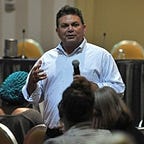Real Maker
Speedchange.at.medium
I’m not much of a fan of what folks call “Project-Based Learning.” What is sold by places like the Buck Institute is, yes — OK, a step away from school-as-totally-boring, but it is not a step toward student-centered learning, nor toward student agency, nor toward the target of intrinsically motivated children.
So, if work on “Project-Based Learning” comes with a warning sticker that says, “CAUTION: This program does not provide a destination, but only a baby steps toward making your school less miserable” — go for it. But understand that “less miserable for kids” should not be your School Improvement Goal.
Where I work we see this continuum. “Project-Based” adds context to content and helps, yes, but it remains entirely teacher determined education. “Problem-Based” adds critical thinking and perhaps creativity, and begins to break down teacher absolutism. “Passion-Based” puts kids and their interests at the center and changes “teachers” into “educators” who are resourcers, advisors, and supporters.
When we reach Passion-Based Learning we are adding content to context, taking the natural curiosity and interests of kids and making education conform to those individual dreams.
Then we offer the next step — Maker Learning. Maker Learning assumes that children create most of the ecosystem around them. They determine not just curricular context but time and space. High school girls see engineering education as taking place in a bridge building project where a stream interrupts a walking trail. Middle school kids see natural science education happening via a high altitude balloon project. A second grader rejects classroom math instruction and designs both a video game and the physical controller for it.
“I look for whatever the ‘spark’ is,” one of our Learning Technology Integrators said last week. “Whatever the kid says, “this interests me — excites me,” and then we’ll build around that. This year he has rural kids deep into stream rainwater analysis via Arduino- controlled sensors; high school kids, elementary school kids, all working together.
“What I want,” the principal of our largest elementary school told me last week, “is for everyone on my faculty to be the expert on something. Our kids would have homeroom teachers as advisors and supporters, but then they’d spend most of the day going to wherever they needed to work on their projects.” And that would be a true maker school — a school developing truly successful, happy humans in adulthood.
Real Maker doesn’t come from kits or recipes. It isn’t learned by attending a one day lecture. You can’t buy it on Amazon.
Real Maker is an attitude toward children — an attitude toward childhood and adolescence. It begins with trust in kids, requires giving up control, requires that we stop saying “but…” and making excuses, requires that we understand that learning is messy and inefficient, requires that we learn to say, “ I don’t know” a lot — and add the phrase, “how can I help you find out?” to that.
Real Maker requires that you challenge yourself and your understandings of time, of space, of behavior, even-yes, of what student safety means.
Can you actually embrace Maker Education? Will you?
- Ira Socol
